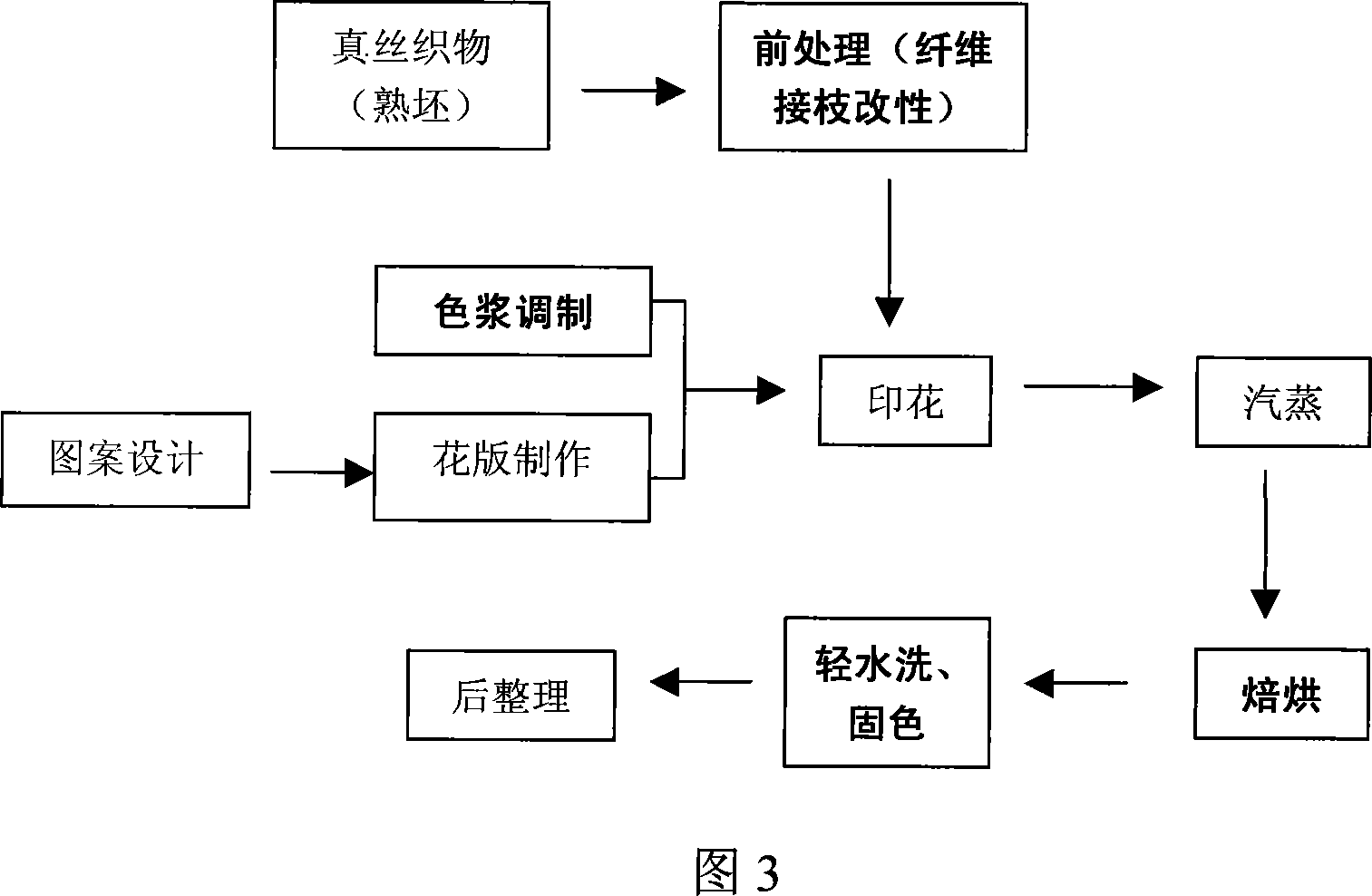Real silk fabric coloring agent printing decoration light water developing and printing flowers method
A silk fabric and printing method technology, applied in the field of textile printing, can solve the problems of sewage treatment, ecological environment damage, complex process, etc., and achieve the effects of reducing sewage discharge, improving color fastness, and increasing dyeing rate
- Summary
- Abstract
- Description
- Claims
- Application Information
AI Technical Summary
Problems solved by technology
Method used
Image
Examples
Embodiment 1
[0029] Embodiment 1: light color (dye consumption X≤1%) printing
[0030] (1) Printing process, as shown in Figure 1:
[0031] (2) Formula and process description:
[0032] 1) Pretreatment (Silk Fiber Graft Modification) formula and process:
[0033] Grafting agent 205: about 30g / L, two dipping and two rolling (at room temperature, 70-80% liquid), and drying at 105-120°C (3-5min).
[0034] Grafting agent 205 was provided by Zhejiang Huasheng Chemical Co., Ltd.
[0035] 2) Color paste formula and instructions:
[0036] Acid or neutral dyes: ≤1%, urea: about 1%, 3% synthetic thickener slurry: 50-70% (under the premise of ensuring that the printing does not bleed, the synthetic thickener slurry should be as little as possible), add water to 100 %.
[0037] Due to the low amount of dye used, there is less floating color after printing and steaming, and generally no washing and desizing are required. Therefore, the paste in the color paste is all made of synthetic thickener p...
Embodiment 2
[0041] Embodiment 2: medium depth (dye consumption X is 1~3%) printing
[0042] (1) printing process, as shown in Figure 2:
[0043] (2) Formula and process description:
[0044] 1) Pretreatment (Silk Fiber Graft Modification) formula and process:
[0045] Grafting agent 205: about 40 g / L, two dipping and two rolling (at room temperature, 70-80% liquid), and drying at 105-120°C (3-5min).
[0046] 2) Color paste formula and instructions:
[0047] Acidic or neutral dyes: 1-3%, urea: about 2%, 3% synthetic thickener pulp: 40-60%, 6% modified sodium alginate pulp: about 10-15% (to ensure that the printing does not bleed Under the premise, the amount of synthetic thickener and sodium alginate pulp should be as little as possible), and add water to 100%.
[0048] Modified sodium alginate is to add 2-3% of anionic detergent (such as cleaning agent 209) to sodium alginate pulp. The detergent can wet and expand the serous film and improve the water washability of the pulp.
[0049...
Embodiment 3
[0053] Embodiment 3: dark color (dyes consumption X is 3~5%) printing
[0054] (1) printing process, as shown in Figure 3:
[0055] (2) Formula and process description:
[0056] 1) Pretreatment (Silk Fiber Graft Modification) formula and process:
[0057] Grafting agent D: about 50g / L, two dipping and two rolling (at room temperature, with 70-80% liquid), and drying at 105-120°C (3-5min).
[0058] Grafting agent D was provided by Hangzhou Kefeng Chemical Co., Ltd.
[0059] 2) Color paste formula and instructions:
[0060] Acid or neutral dye: 3-5%, urea: about 3%, 4% synthetic thickener pulp: 40-50%, 8% modified corn or konjac starch (plant seed glue) pulp: about 15-20% (On the premise of ensuring that the printing does not bleed, the amount of synthetic thickener and sodium alginate pulp should be as little as possible), strengthening agent 201: 1-5%, softener: 1-5%, add water to 100%.
[0061] Due to the high amount of dye used, the fabric after printing and steaming cont...
PUM
 Login to View More
Login to View More Abstract
Description
Claims
Application Information
 Login to View More
Login to View More - R&D
- Intellectual Property
- Life Sciences
- Materials
- Tech Scout
- Unparalleled Data Quality
- Higher Quality Content
- 60% Fewer Hallucinations
Browse by: Latest US Patents, China's latest patents, Technical Efficacy Thesaurus, Application Domain, Technology Topic, Popular Technical Reports.
© 2025 PatSnap. All rights reserved.Legal|Privacy policy|Modern Slavery Act Transparency Statement|Sitemap|About US| Contact US: help@patsnap.com


